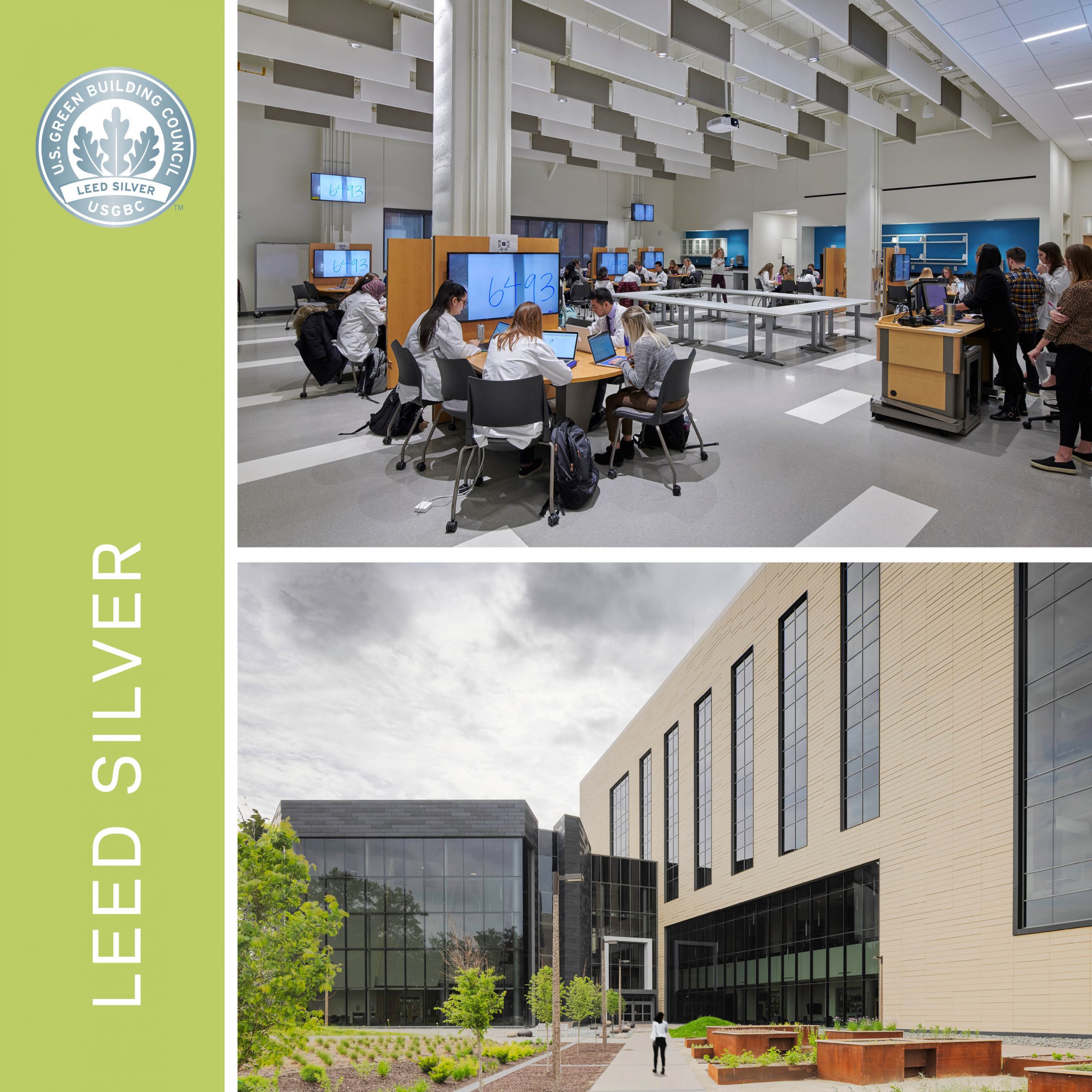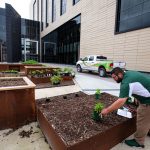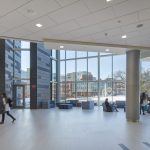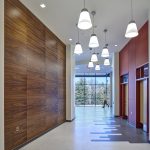College of Pharmacy earns LEED Silver certification

The University of Iowa’s new College of Pharmacy building has earned LEED Silver certification. Complete in December 2019, the building was officially dedicated in 2021 due to COVID-19.
The new 210,000-square-foot building replaced the 1960s College of Pharmacy building with state-of-the-art research spaces and an abundance of active learning and flexible classrooms and small group collaboration areas.
Since 2008, the University of Iowa has incorporated sustainability into its campus development and has made sustainability a priority in its 2022-2027 strategic plan. This is the 20th building on campus to achieve LEED certification, totaling 2.4 million gross square feet.
LEED (Leadership in Energy and Environmental Design), developed by the U.S. Green Building Council (USGBC), is the most widely used green building rating system in the world and an international symbol of excellence.
The construction and operation of buildings represents 40% of the total global carbon emissions. Certification is proof that buildings are going above and beyond to ensure the space is constructed and operated to the highest level of sustainability, which directly reduces each building’s carbon footprint in addition to other positive impacts.
“The University of Iowa’s LEED certification demonstrates tremendous green building leadership,” said Peter Templeton, president and CEO, USGBC. “By prioritizing sustainability, the University of Iowa is helping USGBC continue towards our goal of green buildings for everyone within this generation. Transforming our buildings and spaces happens one project at a time.”
LEED projects earn points by adhering to prerequisites and credits across nine categories. The College of Pharmacy building earned LEED Silver certification under the LEED Building Design + Construction (BD+C): New Construction (NC) v2009.
The majority of the points were earned in four categories: Sustainable Sites (17 points), Water Efficiency (7 points), Energy & atmosphere (7 points), and Indoor Environmental Quality (7 points).

Sustainable Sites: The College of Pharmacy building was constructed on the site of the former Quadrangle Residence Hall. Re-using a previously developed site kept construction within the currently developed campus footprint. The building, which is across the street from the former College of Pharmacy building, also maintained a central location with adjacency to walkable amenities and alternative means of public transportation and bicycle use. When the residence hall was deconstructed,a portion was redeveloped into open green space.

Water Efficiency: The project reduced its water use by utilizing native and adaptive landscaping that did not require an irrigation system and installed low-flush and low-flow plumbing fixtures that resulted in a 35% water reduction.

Energy & Atmosphere: To reduce reliance on artificial light, common public spaces are daylit. Additionally, interior classrooms and collaboration areas borrow light and views using internal windows, which allow exterior light penetration deep into the building. In conjunction with better-than-code insulation levels, the concrete pre-cast construction improves envelope thermal performance, which reduces the HVAC load in addition to reducing maintenance and increasing longevity. The building is projected to achieve a 20% energy savings despite the building containing up to three floors of research labs (two were fit-out during the initial construction phase and the third is currently in design) and the existence of a full-scale pharmaceutical production facility located in the basement.

College of Pharmacy
Indoor Environmental Quality: A major emphasis was placed on high indoor air quality and controllability of the lighting and thermal comfort system. The project utilized materials that were low-emitting, had a recycled content and were regionally sourced. During construction, a Construction Indoor Air Quality Management Plan was implemented, and the energy-related systems were commissioned to ensure that they would perform optimally. After the building was occupied, the commissioning team continued to measure and verify system performance.
The College of Pharmacy building was designed by OPN Architects and constructed by Miron Construction. IMEG provided design for all engineering disciplines.
OPN Architects is a regional design firm with offices in Iowa, Minnesota, and Wisconsin. The firm’s work at the University of Iowa over the last decade includes Hancher Auditorium and renovations at the Pappajohn Business Building, Boyd Law Building, Stanley and Hillcrest residence halls, Gerdin Athletic Learning Center, and Old Capitol.
“Our team takes a holistic approach to sustainability that results in buildings like the College of Pharmacy that both look and perform beautifully,” said Tate Walker, OPN Associate Principal and Director of Sustainability. “Our strategy is to focus on items of practical importance to the operation of a building and invest in those things that support the project’s vision. A building must do more than just mitigate the negative impacts of its construction and operations, it has to build lasting, positive connections among the people it serves in order to be successful.”
